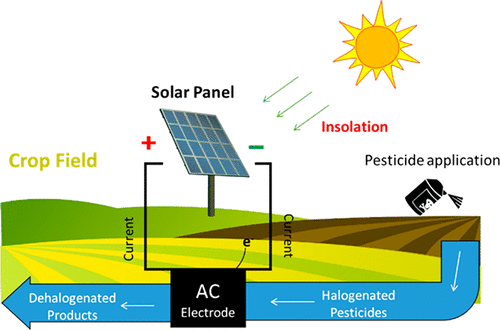当前位置:
X-MOL 学术
›
Environ. Sci. Technol.
›
论文详情
Our official English website, www.x-mol.net, welcomes your
feedback! (Note: you will need to create a separate account there.)
Capture and Reductive Transformation of Halogenated Pesticides by an Activated Carbon-Based Electrolysis System for Treatment of Runoff
Environmental Science & Technology ( IF 10.8 ) Pub Date : 2018-01-10 00:00:00 , DOI: 10.1021/acs.est.7b05259 Yuanqing Li 1 , William A. Mitch 1
Environmental Science & Technology ( IF 10.8 ) Pub Date : 2018-01-10 00:00:00 , DOI: 10.1021/acs.est.7b05259 Yuanqing Li 1 , William A. Mitch 1
Affiliation

|
This study evaluates an electrochemical system to treat the halogenated pesticides, fipronil, permethrin, and bifenthrin, in urban runoff. Compared to the poor sorption capacity of metal-based electrodes, granular activated carbon (GAC)-based electrodes could sorb halogenated pesticides, permitting electrochemical degradation to occur over longer timescales than reactor hydraulic residence times. In a dual-cell configuration, a cathode constructed of loose GAC containing sorbed pesticides was separated from the anode by an ion-exchange membrane to prevent chloride transport and oxidation to chlorine at the anode. When −1 V was applied to the cathode, fipronil concentrations declined by 92% over 15 h, releasing molar equivalents of chloride (2) and fluoride (6), suggesting complete dehalogenation of fipronil. An electrode constructed of crushed GAC particles attached to a carbon cloth current distributor achieved >90% degradation of fipronil, permethrin, and bifenthrin within 2 h under the same conditions. To evaluate a simpler single-cell configuration suitable for scale-up, two of the carbon cloth-based electrodes were placed in parallel without an ion-exchange membrane. For −1 V applied to the cathode, fipronil degradation was >95% over 2 h, and energy consumption declined with closer electrode spacing. However, chloride oxidation at the anode produced chlorine, and the anode degraded. Application of an alternating potential (−1 to +1 V at 0.0125 Hz) to the parallel-plate electrodes achieved >90% degradation of fipronil, bifenthrin, and permethrin over 4 h, releasing chloride at 50–70% of that expected for complete dechlorination. No loss of performance or formation of chlorine or halogenated byproducts was observed over 5 cycles of treating fipronil-spiked surface water.
中文翻译:

活性炭基电解系统捕集和还原卤代农药的径流
这项研究评估了一种用于处理城市径流中的卤化农药,氟虫腈,氯菊酯和联苯菊酯的电化学系统。与金属基电极的较差的吸附能力相比,颗粒状活性炭(GAC)基的电极可以吸附卤化农药,从而允许在比反应堆水力停留时间更长的时间范围内发生电化学降解。在双电池配置中,由包含吸附的农药的松散GAC构成的阴极通过离子交换膜与阳极分离,以防止氯化物在阳极处迁移和氧化成氯。当将-1 V施加到阴极时,氟虫腈的浓度在15小时内下降了92%,释放出摩尔当量的氯离子(2)和氟离子(6),表明氟虫腈完全脱卤。在相同条件下,在2小时内,由附着在碳布电流分配器上的碎GAC颗粒构成的电极可实现90%以上的氟虫腈,苄氯菊酯和联苯菊酯降解。为了评估适合放大的更简单的单电池配置,将两个碳布基电极平行放置而没有离子交换膜。对于施加到阴极的-1 V,氟虫腈在2小时内的降解率> 95%,并且能耗随着电极间距的减小而下降。然而,在阳极处的氯化物氧化产生氯,并且阳极退化。在平行板电极上施加交流电(在0.0125 Hz时为-1至+1 V)可在4 h内使氟虫腈,联苯菊酯和苄氯菊酯降解> 90%,释放出氯离子浓度为预期的50-70%脱氯。
更新日期:2018-01-11
中文翻译:

活性炭基电解系统捕集和还原卤代农药的径流
这项研究评估了一种用于处理城市径流中的卤化农药,氟虫腈,氯菊酯和联苯菊酯的电化学系统。与金属基电极的较差的吸附能力相比,颗粒状活性炭(GAC)基的电极可以吸附卤化农药,从而允许在比反应堆水力停留时间更长的时间范围内发生电化学降解。在双电池配置中,由包含吸附的农药的松散GAC构成的阴极通过离子交换膜与阳极分离,以防止氯化物在阳极处迁移和氧化成氯。当将-1 V施加到阴极时,氟虫腈的浓度在15小时内下降了92%,释放出摩尔当量的氯离子(2)和氟离子(6),表明氟虫腈完全脱卤。在相同条件下,在2小时内,由附着在碳布电流分配器上的碎GAC颗粒构成的电极可实现90%以上的氟虫腈,苄氯菊酯和联苯菊酯降解。为了评估适合放大的更简单的单电池配置,将两个碳布基电极平行放置而没有离子交换膜。对于施加到阴极的-1 V,氟虫腈在2小时内的降解率> 95%,并且能耗随着电极间距的减小而下降。然而,在阳极处的氯化物氧化产生氯,并且阳极退化。在平行板电极上施加交流电(在0.0125 Hz时为-1至+1 V)可在4 h内使氟虫腈,联苯菊酯和苄氯菊酯降解> 90%,释放出氯离子浓度为预期的50-70%脱氯。











































 京公网安备 11010802027423号
京公网安备 11010802027423号